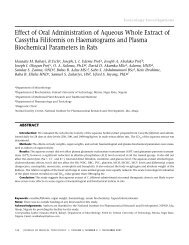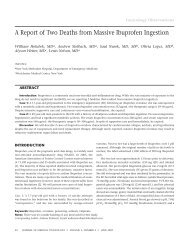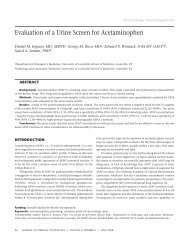Use of Neostigmine for the Management of Drug Induced Ileus in ...
Use of Neostigmine for the Management of Drug Induced Ileus in ...
Use of Neostigmine for the Management of Drug Induced Ileus in ...
You also want an ePaper? Increase the reach of your titles
YUMPU automatically turns print PDFs into web optimized ePapers that Google loves.
Toxicology Observations<br />
<strong>Use</strong> <strong>of</strong> <strong>Neostigm<strong>in</strong>e</strong> <strong>for</strong> <strong>the</strong> <strong>Management</strong><br />
<strong>of</strong> <strong>Drug</strong> <strong>Induced</strong> <strong>Ileus</strong> <strong>in</strong> Severe Poison<strong>in</strong>gs<br />
Dr Betty Chan, MBBS FACEM PhD a , Pr<strong>of</strong>essor Ian Whyte, MBBS FRACP FRCPE bc ,<br />
Pr<strong>of</strong>essor Andrew Dawson, MBBS Dip Epid FRCPE FRACP bc , Dr Michael Downes, Mb ChB b<br />
a Departments <strong>of</strong> Cl<strong>in</strong>ical Toxicology, Pr<strong>in</strong>ce <strong>of</strong> Wales Hospital & Westmead Hospital, Sydney, Australia<br />
b Department <strong>of</strong> Cl<strong>in</strong>ical Toxicology & Pharmacology, Newcastle Mater Misericordiae Hospital, Newcastle, Australia<br />
c Discipl<strong>in</strong>e <strong>of</strong> Cl<strong>in</strong>ical Pharmacology, University <strong>of</strong> Newcastle, Newcastle Australia<br />
ABSTRACT<br />
Introduction: Effective whole bowel irrigation may be difficult <strong>in</strong> <strong>the</strong> presence <strong>of</strong> drug-<strong>in</strong>duced ileus. <strong>Neostigm<strong>in</strong>e</strong>, which <strong>in</strong>hibits<br />
<strong>the</strong> enzymatic degradation <strong>of</strong> acetylchol<strong>in</strong>e, has been suggested to improve drug-<strong>in</strong>duced ileus. We present two poison<strong>in</strong>g<br />
cases <strong>in</strong> which neostigm<strong>in</strong>e was used to facilitate gut decontam<strong>in</strong>ation complicated by ileus.<br />
Case Reports: A 47-year-old woman, after overdose with sodium valproate, venlafax<strong>in</strong>e, and ibupr<strong>of</strong>en, developed ileus that<br />
prevented whole bowel irrigation. <strong>Neostigm<strong>in</strong>e</strong>, 2.5 mg <strong>in</strong>travenously followed by 1.25 mg three hours later, led to improved bowel<br />
transit and successful whole bowel irrigation. A 25-year-old man developed ileus after overdose with venlafax<strong>in</strong>e, dothiep<strong>in</strong>, and<br />
ethanol. <strong>Neostigm<strong>in</strong>e</strong> adm<strong>in</strong>istration led to improved <strong>in</strong>test<strong>in</strong>al motility and successful whole bowel irrigation.<br />
Discussion: We demonstrate facilitated gut decontam<strong>in</strong>ation temporally associated with adm<strong>in</strong>istration <strong>of</strong> neostigm<strong>in</strong>e <strong>in</strong> two<br />
patients judged to have drug-<strong>in</strong>duced ileus follow<strong>in</strong>g overdose. No significant adverse events related to neostigm<strong>in</strong>e were observed.<br />
INTRODUCTION<br />
The management <strong>of</strong> life threaten<strong>in</strong>g poison<strong>in</strong>gs from slow release<br />
medications <strong>of</strong>ten poses a cl<strong>in</strong>ical challenge to physicians.<br />
Multiple doses <strong>of</strong> activated charcoal may be used <strong>for</strong> drugs<br />
(such as <strong>the</strong>ophyll<strong>in</strong>e and carbamazep<strong>in</strong>e) that have a significant<br />
enterohepatic circulation. For extended release medications<br />
and drugs that do not benefit from repeated doses <strong>of</strong> activated<br />
charcoal, whole bowel irrigation has been recommended <strong>for</strong><br />
gastro<strong>in</strong>test<strong>in</strong>al decontam<strong>in</strong>ation [1]. However, whole bowel irrigation<br />
is not feasible <strong>in</strong> patients who develop drug <strong>in</strong>duced<br />
ileus. A number <strong>of</strong> randomized studies have demonstrated<br />
that neostigm<strong>in</strong>e can be used to manage patients with colonic<br />
ileus [2–3]. <strong>Neostigm<strong>in</strong>e</strong> has been successfully used <strong>in</strong> a patient<br />
with antichol<strong>in</strong>ergic drug <strong>in</strong>duced ileus [4]. We will present two<br />
cases <strong>of</strong> poison<strong>in</strong>g complicated by ileus where neostigm<strong>in</strong>e was<br />
used to facilitate gut decontam<strong>in</strong>ation.<br />
CASE 1<br />
A 47-year-old woman (weigh<strong>in</strong>g 70 kg) was presented with a<br />
history <strong>of</strong> hav<strong>in</strong>g <strong>in</strong>gested 190 200 mg (38 g) <strong>of</strong> sodium<br />
valproate, 53 150 mg (7.95 g) <strong>of</strong> venlafax<strong>in</strong>e, and 12 200 mg<br />
(2.4 g) <strong>of</strong> ibupr<strong>of</strong>en 3 hours be<strong>for</strong>e presentation to a peripheral<br />
hospital. On exam<strong>in</strong>ation, she was haemodynamically stable<br />
with a GCS 15. Neurological exam<strong>in</strong>ation revealed hyperreflexia<br />
Keywords: neostigm<strong>in</strong>e, ileus, venlafax<strong>in</strong>e, overdose<br />
Correspond<strong>in</strong>g Author: Betty Chan, PhD, Department <strong>of</strong> EM, Royal Pr<strong>in</strong>ce Alfred Hospital, Missenden Road, Camperdown 2050 Nsw, Australia.<br />
Email: bschan@ozemail.com.au<br />
JOURNAL OF MEDICAL TOXICOLOGY ■ VOLUME 1, NUMBER 1 ■ DECEMBER 2005 19
with clonus <strong>in</strong> <strong>the</strong> lower limbs. She was treated with 50 g <strong>of</strong><br />
activated charcoal. Eleven hours post <strong>in</strong>gestion, she became<br />
haemodynamically unstable with a systolic blood pressure<br />
<strong>of</strong> 85–90 mm Hg, a s<strong>in</strong>us tachycardia <strong>of</strong> 110–120 beats per<br />
m<strong>in</strong>ute, and a fluctuat<strong>in</strong>g GCS between 8 and 12. The patient<br />
was resuscitated with <strong>in</strong>travenous fluids, norep<strong>in</strong>ephr<strong>in</strong>e <strong>in</strong>fusion<br />
(4 g/kg/m<strong>in</strong>), <strong>in</strong>tubated, and transferred to a nearby<br />
referral hospital. On arrival at <strong>the</strong> Intensive Care Unit, she was<br />
stable and <strong>the</strong> <strong>in</strong>itial valproate concentration was 2468 mol/L<br />
(350–700 mol/L) 9 hrs post <strong>in</strong>gestion. Her serum ammonia<br />
level was 100 mol/L (15–50 mol/L). Her liver function tests<br />
and acid base status were normal. She was treated with<br />
haemodialysis <strong>for</strong> 5 hours because <strong>the</strong> patient had an ileus and<br />
was show<strong>in</strong>g some signs <strong>of</strong> severe valproate toxicity. The valproate<br />
concentration came down from 1949 to 816 mol/L<br />
dur<strong>in</strong>g haemodialysis (Figure 1).<br />
Attempts were made to commence whole bowel irrigation,<br />
but <strong>the</strong> patient had developed an ileus. She was given 2.5 mg<br />
neostigm<strong>in</strong>e IV over 1 m<strong>in</strong>ute. A bowel movement was observed<br />
with<strong>in</strong> 5 m<strong>in</strong>utes, and pill fragments were seen mixed with <strong>the</strong><br />
bowel motion. A transient hypotension was observed, but it responded<br />
to <strong>in</strong>travenous fluid. A second 1.25 mg dose <strong>of</strong> neostigm<strong>in</strong>e<br />
was given 3 hours after <strong>the</strong> first dose to cont<strong>in</strong>ue <strong>the</strong> bowel<br />
movement. The whole bowel irrigation was completed after 24<br />
hours and <strong>the</strong> patient was extubated <strong>the</strong> next morn<strong>in</strong>g.<br />
CASE 2<br />
A 25-year-old man was presented to a peripheral hospital with a<br />
history <strong>of</strong> hav<strong>in</strong>g <strong>in</strong>gested 90 150 mg <strong>of</strong> venlafax<strong>in</strong>e (13.5 g);<br />
30 25 mg <strong>of</strong> dothiep<strong>in</strong> (750 mg); and <strong>in</strong>gestion <strong>of</strong> some alcohol.<br />
On <strong>in</strong>itial assessment, he was alert and orientated, with a<br />
HR <strong>of</strong> 148/m<strong>in</strong> and a BP <strong>of</strong> 150/66 mm Hg. Soon after arrival at<br />
<strong>the</strong> Emergency Department, he developed a grand mal seizure<br />
and was treated with 3 mg midazolam IV. He was <strong>in</strong>tubated and<br />
given activated charcoal. He was acidotic with a pH 7.3, a pCO 2<br />
51 mm Hg, and a BE 1 mmol/l. He was given NaHCO 3<br />
<strong>for</strong> prolonged<br />
QRS on an ECG. He was thought to have cont<strong>in</strong>uous<br />
seizure activity and was managed with phenobarbitone <strong>in</strong>fusion.<br />
He was transferred to a tertiary referral hospital. On arrival at <strong>the</strong><br />
ICU, he was noted to have had dilated pupils, normal active<br />
bowel sounds, and was hyperreflexic with non-susta<strong>in</strong>ed clonus.<br />
He was commenced on whole bowel irrigation with polyethylene<br />
glycol (1L/hr). Ten hours after admission to <strong>the</strong> hospital, he<br />
was noted to have had abdom<strong>in</strong>al distension with reduced<br />
bowel sounds and an ileus. He had not passed any faecal fluid,<br />
and polyethylene glycol was be<strong>in</strong>g passively regurgitated. The<br />
phenobarbitone and morph<strong>in</strong>e <strong>in</strong>fusion were ceased. He was<br />
given 2.5 mg neostigm<strong>in</strong>e IV over 20 m<strong>in</strong>utes. At 10 m<strong>in</strong>utes his<br />
bowel sounds were noted to be active, and he passed a large<br />
amount <strong>of</strong> rectal effluent. This subsequently cont<strong>in</strong>ued with a<br />
rate <strong>of</strong> 1L/hr rectal effluent, with a mixture <strong>of</strong> pills and fluid. He<br />
cont<strong>in</strong>ued to be acidotic with a pH 7.26, a pCO 2<br />
40 mm Hg, and<br />
a BE 7.8. He was treated with NaHCO 3<br />
. Whole bowel irrigation<br />
was cont<strong>in</strong>ued <strong>for</strong> 48 hours and was ceased when pill fragments<br />
were no longer visible. Soon after, he was extubated.<br />
DISCUSSION<br />
Colonic ileus is a cl<strong>in</strong>ical picture <strong>of</strong> a mechanical obstruction <strong>in</strong><br />
<strong>the</strong> absence <strong>of</strong> any demonstrable occlusion <strong>of</strong> <strong>the</strong> gut. This is<br />
first described by Ogilvie [5]. It can ei<strong>the</strong>r be due to sympa<strong>the</strong>tic<br />
overactivity or parasympa<strong>the</strong>tic suppression. The use <strong>of</strong> neostigm<strong>in</strong>e<br />
<strong>for</strong> <strong>the</strong> management <strong>of</strong> colonic ileus or acute colonic<br />
Concentration<br />
(umol/l)<br />
3000<br />
2500<br />
2000<br />
1500<br />
1000<br />
500<br />
0<br />
Serum Valproate Concentration<br />
versus time<br />
0 20 40 60<br />
Hours<br />
Haemodialysis <strong>for</strong> 5 hours<br />
Figure 1. Serum Valproate Concentration versus Time.<br />
20 JOURNAL OF MEDICAL TOXICOLOGY ■ VOLUME 1, NUMBER 1 ■ DECEMBER 2005
pseudo-obstruction has been well documented [2–4]. In both <strong>of</strong><br />
our patients, it was considered critically important that <strong>the</strong>y<br />
should have an adequate bowel washout, but <strong>the</strong> ileus made a<br />
bowel washout impossible. The use <strong>of</strong> neostigm<strong>in</strong>e produced an<br />
impressive response with<strong>in</strong> 5 m<strong>in</strong>utes and had m<strong>in</strong>imal adverse<br />
effects. With <strong>the</strong> first patient, a second dose was required because<br />
<strong>of</strong> <strong>the</strong> drug’s short duration <strong>of</strong> action. We postulate that<br />
<strong>the</strong> clear temporal response <strong>of</strong> cl<strong>in</strong>ical ileus to <strong>the</strong> adm<strong>in</strong>istration<br />
<strong>of</strong> neostigm<strong>in</strong>e <strong>in</strong> both patients is evidence <strong>of</strong> its efficacy. In<br />
this cl<strong>in</strong>ical situation, neostigm<strong>in</strong>e successfully facilitated whole<br />
bowel irrigation.<br />
<strong>Neostigm<strong>in</strong>e</strong> is a peripheral chol<strong>in</strong>esterase <strong>in</strong>hibitor. It <strong>in</strong>duces<br />
smooth muscle contraction and propulsion, perhaps by<br />
stimulat<strong>in</strong>g <strong>the</strong> muscar<strong>in</strong>ic receptors <strong>in</strong> <strong>the</strong> myenteric plexus. It<br />
has a volume <strong>of</strong> distribution at 0.5–1 L/kg and a plasma half-life<br />
<strong>of</strong> 20–60 m<strong>in</strong>utes after <strong>in</strong>travenous adm<strong>in</strong>istration. Side effects<br />
<strong>in</strong>clude salivation, nausea, vomit<strong>in</strong>g, abdom<strong>in</strong>al pa<strong>in</strong>, bradycardia,<br />
hypotension, and bronchospasm. Dur<strong>in</strong>g neostigm<strong>in</strong>e <strong>in</strong>fusion,<br />
patients should have cardiac monitor<strong>in</strong>g with atrop<strong>in</strong>e<br />
available. Contra-<strong>in</strong>dications <strong>in</strong>clude an HR 60/m<strong>in</strong> and an<br />
SBP 90 mm Hg if patients are on beta-blockers, acidotic, or<br />
have had recent myocardial <strong>in</strong>farct. Both <strong>of</strong> our patients were<br />
normotensive when neostigm<strong>in</strong>e was adm<strong>in</strong>istered. Inotropic<br />
support was provided <strong>for</strong> <strong>the</strong> first patient. The second patient<br />
had an unclear cause <strong>of</strong> mild persistent acidosis, possibly related<br />
to <strong>the</strong> bicarbonate loss from <strong>the</strong> gut due to <strong>the</strong> previous<br />
whole bowel irrigation. Ano<strong>the</strong>r potential danger is a bezoar [6]<br />
that causes a mechanical bowel obstruction. Strong peristalsis<br />
produced by neostigm<strong>in</strong>e may result <strong>in</strong> colonic per<strong>for</strong>ation.<br />
This may have to be ruled out with a water-soluble contrast enema<br />
be<strong>for</strong>e neostigm<strong>in</strong>e is given.<br />
A recent volunteer study by Amato et al. [7] was per<strong>for</strong>med<br />
to evaluate <strong>the</strong> use <strong>of</strong> neostigm<strong>in</strong>e and erythromyc<strong>in</strong> as prok<strong>in</strong>etic<br />
agents to limit <strong>the</strong> gut absorption <strong>of</strong> a <strong>the</strong>rapeutic adult<br />
dose <strong>of</strong> extended-release acetam<strong>in</strong>ophen (1300 mg). When compared<br />
with <strong>the</strong> control phase, <strong>the</strong> study failed to demonstrate<br />
any difference <strong>in</strong> <strong>the</strong> elim<strong>in</strong>ation <strong>of</strong> acetam<strong>in</strong>ophen by ei<strong>the</strong>r<br />
neostigm<strong>in</strong>e or erythromyc<strong>in</strong>. The f<strong>in</strong>d<strong>in</strong>gs <strong>of</strong> <strong>the</strong> study cannot<br />
be extrapolated to patients who have taken a potentially fatal<br />
dose <strong>of</strong> extended release medications and who are receiv<strong>in</strong>g<br />
<strong>in</strong>terventions known to reduce gastro<strong>in</strong>test<strong>in</strong>al transit time.<br />
While neostigm<strong>in</strong>e may be shown to be <strong>in</strong>effective <strong>in</strong> patients<br />
with normal gut motilities, it may have an important role <strong>in</strong> patients<br />
that have colonic pseudo-obstruction but who need to<br />
undergo whole bowel irrigation to remove rema<strong>in</strong><strong>in</strong>g tox<strong>in</strong>s <strong>in</strong><br />
<strong>the</strong> gut.<br />
Severe valproate toxicity occurs with overdoses exceed<strong>in</strong>g<br />
400 mg/kg. Overdoses <strong>of</strong> sodium valproate can cause multiorgan<br />
failures that <strong>in</strong>clude paradoxical seizures, coma, cerebral<br />
edema, metabolic acidosis, bone marrow failure (leucopenia,<br />
thrombocytopenia), abnormal LFT (hyperammonaemia) and<br />
circulatory collapse. The management <strong>of</strong> severe sodium valproate<br />
poison<strong>in</strong>g <strong>in</strong>cludes supportive management, multiple<br />
dose activated charcoal—and (<strong>in</strong> patients who are unstable)<br />
haemodialysis or haemoperfusion is recommended. Haemodialysis<br />
may result <strong>in</strong> a four to five-fold decrease <strong>in</strong> elim<strong>in</strong>ation<br />
half life <strong>in</strong> overdose patients. In addition, dialysis can remove<br />
metabolic disturbances and valproic acid metabolites. In <strong>the</strong> first<br />
case, haemodialysis may not have been <strong>in</strong>dicated because <strong>the</strong><br />
literature suggests that a sodium valproate level 5900 mol/L<br />
can be successfully managed with conservative treatment [7].<br />
The co-<strong>in</strong>gestion <strong>of</strong> a large dose <strong>of</strong> venlafax<strong>in</strong>e may have contributed<br />
to <strong>the</strong> haemodynamic <strong>in</strong>stability [8].<br />
The most common toxic symptoms <strong>for</strong> venlafax<strong>in</strong>e are<br />
seizures and excessive seroton<strong>in</strong> activity. Toxic symptoms <strong>in</strong>clude<br />
agitation, delirium, tremor, clonus, fever, and o<strong>the</strong>r symptoms.<br />
The toxicity usually appears with<strong>in</strong> 6 hours <strong>for</strong> standard release<br />
poison<strong>in</strong>g, but it may be delayed <strong>for</strong> 12–15 hours <strong>in</strong> extended release<br />
poison<strong>in</strong>g. Although <strong>the</strong> mechanism <strong>of</strong> seizure activity is<br />
unclear, <strong>in</strong>gestion <strong>of</strong> 1 g <strong>of</strong> venlafax<strong>in</strong>e has been reported to<br />
cause seizures. Animal models suggest that <strong>the</strong> cardiotoxicity<br />
and QRS widen<strong>in</strong>g are due to Na channel blockade [4]. Fatal<br />
and non-fatal ventricular arrhythmias have been reported with<br />
large <strong>in</strong>gestions <strong>of</strong> venlafax<strong>in</strong>e (>7g).<br />
Treatment <strong>of</strong> extended release venlafax<strong>in</strong>e is ma<strong>in</strong>ly supportive<br />
<strong>for</strong> seizure control and avoid<strong>in</strong>g <strong>the</strong> use <strong>of</strong> sodium<br />
channel block<strong>in</strong>g drugs that can exacerbate cardiotoxicity.<br />
Some success has been reported with <strong>the</strong> use <strong>of</strong> sodium bicarbonate<br />
<strong>for</strong> <strong>the</strong> management <strong>of</strong> cardiac arrhythmias. Aggressive<br />
gut decontam<strong>in</strong>ation with activated charcoal and whole bowel<br />
irrigation is recommended <strong>for</strong> toxic doses <strong>of</strong> extended release<br />
preparations.<br />
In both our cases, whole bowel irrigation was hampered by<br />
<strong>the</strong> presence <strong>of</strong> ileus <strong>in</strong>duced by <strong>the</strong> poison<strong>in</strong>gs. Both patients<br />
had <strong>in</strong>gested a potentially fatal dose <strong>of</strong> extended release venlafax<strong>in</strong>e.<br />
The first patient had a significant co-<strong>in</strong>gestion <strong>of</strong> valproate,<br />
and <strong>the</strong> second patient had a co-<strong>in</strong>gestion <strong>of</strong> dothiep<strong>in</strong>.<br />
<strong>Neostigm<strong>in</strong>e</strong> appeared to reverse <strong>the</strong> ileus to allow gut decontam<strong>in</strong>ation<br />
to occur. Fur<strong>the</strong>r studies are required to demonstrate<br />
<strong>the</strong> efficacy <strong>of</strong> neostigm<strong>in</strong>e <strong>in</strong> <strong>the</strong> management <strong>of</strong> drug <strong>in</strong>duced<br />
ileus <strong>in</strong> severe poison<strong>in</strong>gs.<br />
REFERENCES<br />
1. Tenenbe<strong>in</strong> M. Position statement: whole bowel irrigation.<br />
American Academy <strong>of</strong> Cl<strong>in</strong>ical Toxicology; European Association<br />
<strong>of</strong> Poisons Centres and Cl<strong>in</strong>ical Toxicologists. J Toxicol Cl<strong>in</strong><br />
Toxicol. 2000;38:689–690.<br />
2. Ponec RJ, Saunders MD, Kimmey MB. <strong>Neostigm<strong>in</strong>e</strong> <strong>for</strong> <strong>the</strong><br />
Treatment <strong>of</strong> Acute Colonic Pseudo-obstruction. NEJM<br />
1999;341:137–141.<br />
3. Van der Spoel JI, Oudemans-van Straaten HM,<br />
Stoutenbeek CP, Bosman RJ, Zandstra DF. <strong>Neostigm<strong>in</strong>e</strong><br />
Resolves Critical Illness Related Colonic <strong>Ileus</strong> <strong>in</strong> Intensive<br />
Care Patients with Multiple Organ Failure—a Prospective,<br />
JOURNAL OF MEDICAL TOXICOLOGY ■ VOLUME 1, NUMBER 1 ■ DECEMBER 2005 21
Double-Bl<strong>in</strong>d, Placebo Controlled Trial. Int Care Med.<br />
2001;27:822–827.<br />
4. Isbister FK, Oakley P, Whyte I, Dawson A. Treatment <strong>of</strong><br />
Anti-chol<strong>in</strong>ergic <strong>Induced</strong> <strong>Ileus</strong> with <strong>Neostigm<strong>in</strong>e</strong>. Ann Emerg<br />
Med. 2001;38:689–693.<br />
5. Olgilvie H. Large-Intest<strong>in</strong>al Colic due to Sympa<strong>the</strong>tic<br />
Deprivation. A New Cl<strong>in</strong>ical Syndrome. BMJ. 1948;2:671–673.<br />
6. Brubacher JR, Lev<strong>in</strong>e B, H<strong>of</strong>fman RS. Intest<strong>in</strong>al pseudoobstruction<br />
(Ogilvie’s syndrome) <strong>in</strong> <strong>the</strong>ophyll<strong>in</strong>e overdose. Vet<br />
Hum Toxicol. 1996;38:368–70.<br />
7. Amato CS, Wang RY, Wright RO, L<strong>in</strong>akis JG. Evaluation<br />
<strong>of</strong> Promotility Agents to Limit <strong>the</strong> Gut Bioavailability <strong>of</strong><br />
Extended-Release Acetam<strong>in</strong>ophen. J Toxicol Cl<strong>in</strong> Toxicol.<br />
2004;42:73–77.<br />
22 JOURNAL OF MEDICAL TOXICOLOGY ■ VOLUME 1, NUMBER 1 ■ DECEMBER 2005





